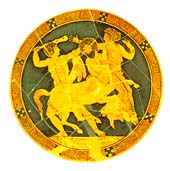Pelion

Traditional Pelion Architecture
Major Villages of Pelio

Printing (420 to 410 B.C.) on a Greek cup; courtecy of the Museum of
Fine Arts, Boston, Pierce Fund.
The Centaursin Greek mythology, were part human and part
horse. In one myth, pictured here, a centaur attempted to attack Dearina, the
wife of Hercules. But Hercules rescued her.
Pelion, land of the legendary Centaurs, the site chosen by the ancient gods for
their weddings nd celebrations, rises in lush magnificence to the northeast of
Volos.
It was here that the centaur Chiron, the wise teacher of demigods and heroes,
gave his pupils daily instruction in the proper care of body and soul. Here,
too, the first beauty contest took place between Thetis and Eris.
``Many leaved'' Pelion was an inspiration to Homer, Pindar and Euripides but
also to the more modern popular muse who sung of the unquenchable desire of the
Greek people for freedom.
The highest peaks of Pelion (Pliasidi, 1.548 m.,Pourianos Stavros, 1.610 m.) are
in the northern part of the range. Its inaccessible eastern flank, with the
Aegean stretching out into the distance like a vast mirror, comes to an abrupt
end in the sea, creating wildly beautiful rocky shores. Conversely, the
tranquil, calm coast of the western flank on the Pagasitic gulf is much easier
to reach and encourages shipping activity.
Pelion's picturesque villages, sometimes clinging to wooded slopes or perched on
steep bluffs, sometimes hidden away in verdant ravines, are so much a part of
the scenery that, seen form distance they create the impression of having
``sprouted up'' along with trees.
The distinctive traditional architecture of the old houses with the narrow
windows and decorated walls, stone stairways and roofs of grey or green slate;
the Byzantine churches with wonderful wall paintings and icon screens; the
winding cobbled paths, sculpted fountain, courtyards redolent of basil and
gardenia; squares paved with huge flag stones where the cheerful bubbling of a
little brook is never absent - are all typical features of a Pelion village.
Northeast Pelion
Climbing northeast of Volos, the road bisects the charming suburb of Ano Volos
(5 km.), with the sleep hill of Episkopi demarcating its eastern side. At the
nearby villages of Anakasia and Alli Meria, where there are some wall paintings
by Theophilos, it is worth stopping to admire the panoramic view of the
Pagasitic gulf and the plain of Thessaly while seated in one of the district's
picturesque restaurants.
Along the Pagasitic Gulf
The road southeast of Volos leads to Agria (8 km. from Volos), a coastal suburb
with an extensive beach in a fertile district filled with olive groves and
orchards. Here you will find a number of hotels and restaurants. The chapel of
the Virgin of Coritsa and the icon screen with carved and painted scenes from
everyday life in the chapel of the Holy Cross are sure to leave an impression.
From Agria a secondary road rises 12 km to Drakia (17.5 km from Volos, alt. 500
m.) a village characterized by lush vegetation, running streams, well-made
alleyways and marvellous popular ``tower houses''. The Triantaphyllou mansion,
decorated with 18th century wall paintings, carved doorways and molded ceilings
is considered among the best of its kind. The main square, thought by historians
to be the oldest in Pelion, hosts a folk festival on the 23rd of August,
complete with traditional costumes and music.
After Agria the main road passes by Kato and Ano Lehonia, where most of Pelion's
cultivated flowers are grown and sold. The air is scented with the blossoms of
gardenias, heartiness camellias and tuberoses.
Platanidia, the port of Ano Lehonia, 13 km. from Volos is a good place for fresh
fish.
Continuing south the main road proceeds towards the long beach of Malaki before
arriving at Kato Gatzea (17 km.), a village blessed with protected beaches and
surrounded by a vast olive grove.
Next comes Kala Nera (20 km. from Volos), another seaside village with a beach,
leafy plane trees, orchards and abundant water.


